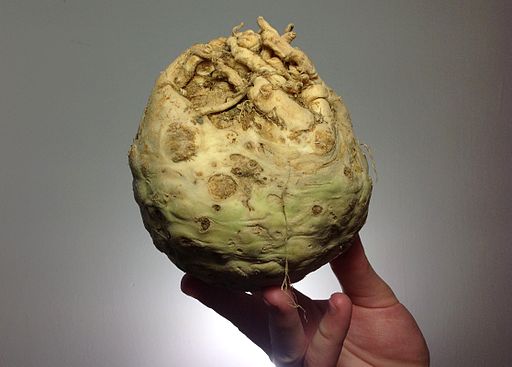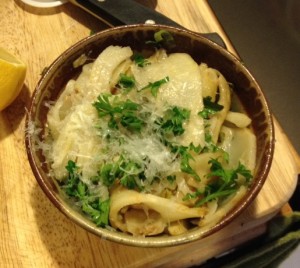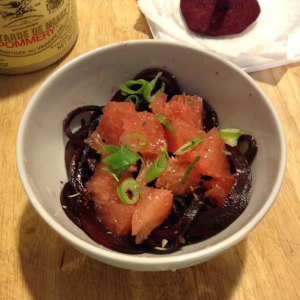This is a cautionary tale about the perils of chairs, trackpads, and root vegetables. I got a spiral vegetable cutter last Christmas. At the time, I made the (remarkably prescient) statement that readers should expect exclamations along the lines of “Hells yeah, spiralized celeriac!” Little did I know that spiralized celeriac would be the last straw for my right arm. Six months later, I have recovered enough to write about it without risking an aftermath of incapacity and icepacks.
For more than twenty years, my work has consisted mostly of thinking, typing, clicking, and scrolling. My right hand spends long periods on a keyboard, mouse, or trackpad. Outside of work, my smartphone has often been in my hand for hours a day. The way I cook involves heavy pans, tongs, and a lot of stirring and whisking. I’ve never owned a food processor; I like my knives, and I do a lot of precise chopping. I spend at least six hours a week in the car. I also do a variety of arty-crafty things, like drawing complex doodles in meetings, and spinning wool with a drop spindle (sometimes). Ergonomics and carpal tunnel syndrome have been topics of interest to me since the early 1990s. What I wasn’t fully aware of was just how far an untreated injury can throw other things out of whack.
Four or five years ago, I was camping with friends on uneven terrain. With a mug in one hand and two cookies in the other, I attempted to sit in a chair. Unfortunately, the chair’s right rear leg was not on the ground. It was in the air, at the top of a slight incline. Witnesses described my fall as “graceful.” I released my mug gently onto the pine-needle-soft ground. It spilled, but didn’t break. I did not drop the cookies. My right shoulder took most of the impact, and made an upsetting crunching/popping noise as it pressed up against my ear.
Friends untangled me, saved my cookies, helped me up, and asked me to move my arm. Everyone agreed that my collarbone was not broken, but that I should go to a doctor if it still felt bad by the end of the weekend. When it was time to go home, my shoulder was undeniably injured, but it fell into the category of “not that bad”–I could get dressed, and drive a car. I wasn’t even bruised.
So, strictly speaking, the past six months of discomfort, inconvenience, and lack of activities involving arm competence are not the celeriac’s fault.

Celeriac is a beautiful thing inside an ugly thing. Most celeriac (also called celery root) is now sold pre-trimmed, looking like a large warty greenish-brown turnip.
When I first started seeing it in stores, it was an alien being–hairy and tentacled, with fibrous stalks growing from the top (they taste like celery, but they’re too tough to eat). Intimidating.

The push-and-crank motion required to force it through the blades was difficult. It was too tough for the teeth that cut the “noodles”–it ended up more like a single inch-wide ribbon with pretty score marks. I sautéed it in butter with thyme. Topped with a squeeze of lemon juice, parsley, and some Parmigiano-Reggiano, it was the second course of a strange and beautiful little dinner with a friend.

The first course had been a rather stunning salad of warm beet noodles with suprêmes of pink grapefruit, in a vinaigrette of its own juice with Pommery mustard, grassy-peppery olive oil, and scallions.

I suppose the process of making suprêmes was a contributing factor. I could blame the beet, too, since that was also difficult to run through the slicer. But it was holding a glass bowl (fingers underneath, thumb on the rim) in my right hand and scooping cooked celeriac into it with my left that finally overwhelmed my arm’s material tolerances.
Result: Sprained right hand. Acute tennis elbow. Dramatic manifestation of repetitive motion damage in hand and arm tendons. Inability (in the short term) to pick up my hairbrush, drink coffee in the car, or use a chef’s knife. Dark days.
It was explained to me that, since the chair incident, all of the structures in my arm had been compensating for the damaged shoulder–and slowly mis-aligning and straining themselves in the process. Physical therapy has included joint manipulation to shift the end of my radius back into its original relationship with my elbow (they had become somewhat estranged); convincing my thumb and wrist to similarly reorganize; and re-acquainting my shoulder blades with each other. That’s going well, but taking time. [Edited to add: It took 480 days. I had my last PT appointment on April 25, 2016.]
There are two morals to this story, as I see it:
- Internal crunching or popping noises/sensations–even if they are “not that bad”–go on the list of “mandatory doctor visit” triggers, and
- Some vegetables need to be baked, roasted, or blanched before spiral-cutting them is advisable.
There are silver linings. I feel better equipped to take care of myself in the long run. I know what I have to do in order to be able to use my cast iron Dutch oven when I am an old lady. I see new value in what I used to consider pointless “shortcut groceries” like pre-shredded “coleslaw mix” and “cracker-cut” cheese. And I’m more careful about sitting in chairs.